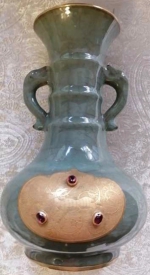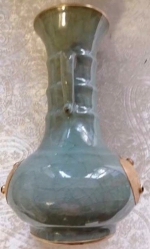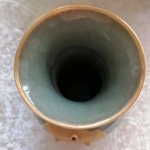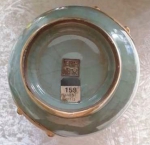古玩城2020精品推荐第八期:北宋汴京官窑瓷器
宋代是中国古代陶瓷史上最辉煌的时期,名窑荟萃,群星灿烂,“官窑”为宋代五大名窑之一,由官府直接营建,是宋瓷这顶皇冠上最耀眼的一颗明珠。有北宋官窑、南宋官窑之分。宋顾文荐《负喧杂录》记“宣政间京师自置窑烧造,名曰官窑”。据此可知,北宋后期在汴京(今河南开封)设官窑,现称“汴京官窑”,亦称“北宋官窑”。北宋官窑集北宋时期青瓷窑艺精华之大成;溶天文地理和儒道学说于一体,创官窑之先例,开瓷质礼器之先河,树开片为饰的新风;其品质之高,器型之美,开片之奇,内涵之深可谓登峰造极,空前绝后,为后世所推崇和景仰。
Song Dynasty is the most brilliant period in the history of ancient China ceramics. Famous kilns are gathered and stars are brilliant. The "official kiln" is one of the five famous kilns in Song Dynasty. It is directly built by the government. It is the most dazzling pearl on the crown of song porcelain. There are Northern Song Dynasty official kilns, Southern Song Dynasty kiln. "The book of negative noise" by Gu wenrecommend in Song Dynasty records that "the Jingshi built the kiln by himself in xuanzheng, which is called the official kiln". According to this, the later period of the Northern Song Dynasty set up a kiln in Bianjing (now Kaifeng, Henan Province), now known as "Bianjing official kiln", also known as "Northern Song Dynasty official kiln". Reach the peak of perfection surpass the past and future. The Northern Song Dynasty official kiln set up the great achievements of celadon kiln art in the Northern Song Dynasty. It dissolved in the astronomical geography and Confucianism and Taoism, and created a precedent for the official kiln. The first thing to start with porcelain sacrificial vessels is to open up the new style of wind.
宋高宗南渡后,在临安(今杭州)另立新窑,为南宋官窑。宋叶《坦斋笔衡》载“中兴渡江,有邵成章提举后宛,号邵局,袭故宫遗制,置窑于修内司,造青器名内窑,澄泥为范,极其精致,油色莹澈,为古所珍。后效坛下别立新窑,比旧窑大不侔矣。”此文表明,南宋初营建的“官窑”有二:一是“修内司官窑”,亦称“内窑”,明高濂《遵生八笺》说,修内司官窑的地点在杭州凤凰山下,但确切的窑址尚未发现;二是“郊坛官窑”,位于杭州市南郊乌龟山一带,亦称“乌龟山官窑”。1930年发现窑址,1956、1985年冬至1986年春先后进行两次考古发掘,发掘出龙窑与作坊遗迹,并获得大量标本。
After Gaozong of Song Dynasty went to the south, he set up a new kiln in Lin'an (today's Hangzhou), which was the official kiln of the Southern Song Dynasty. According to tanzhai biheng written by song ye, it is recorded that "in Zhongxing crossing the river, Shao Chengzhang raised Houwan, named Shaoju. He inherited the Imperial Palace's legacy and placed the kiln in xiuneisi. The Qingqi ware was named neiyao, and the Chengni was the model. It was extremely exquisite and the oil color was crystal clear and precious in ancient times. After the effect of the new kiln under the altar, than the old kiln is not Mou Yi. " This paper shows that there are two kinds of "GUANYAO" built in the early Southern Song Dynasty: one is "xiuneisiguan kiln", also known as "neiyao". According to Zunsheng bajian written by Gao Lian of the Ming Dynasty, the location of Nei Si Guan kiln is at the foot of Fenghuang Mountain in Hangzhou, but the exact kiln site has not been found; the other is Jiaotan Guan kiln, which is located in Wugui mountain area in the southern suburb of Hangzhou city. The kiln site was discovered in 1930. Two archaeological excavations were carried out from the winter of 1956 and 1985 to the spring of 1986. A large number of specimens were obtained.
官窑产品专供宫廷,以宫廷生活用瓷与陈设瓷为主。流传至今的官窑瓷器有碗、盘、碟、盏托、洗、瓶、炉、尊等,样式多种。官窑青瓷闻名于世,北宋汴京官窑青瓷继汝窑烧造,其形制、釉色、工艺与汝窑有共同之处。《格古要论》说汴京官窑器“色好者与汝窑相类”。器多仿古,釉色有淡青、粉青、灰青等多种色调,釉质匀润莹亮,大纹片,胎骨深灰或紫色,满釉裹足支烧,器底有支钉痕。
The products of the official kilns are specially designed for the court, mainly for palace life and furnishings. There are many styles of official porcelain, such as bowls, plates, dishes, saucers, washes, bottles, furnaces and zuns. The Celadon of the official kiln is famous in the world. The Celadon of Bianjing official kiln in Northern Song Dynasty was fired by Ru kiln. Its shape, glaze color and craft have something in common with Ru kiln. According to gegu Yaolun, Bianjing's official kiln ware is similar to Ru kiln in color. The glaze is light blue, pink blue, gray blue and other colors. The glaze is smooth and bright, with large grain, and the fetal bone is dark gray or purple. The glaze is full of glaze and the feet are burned. There are nail marks on the bottom of the ware.
南宋官窑是北宋汴京官窑的继续,郊坛官窑考古发掘的资料表明,南宋早期的青瓷产品,为薄胎薄釉青瓷,胎薄质细,色黑褐或深灰,釉色以粉青为主,兼有青灰、青黄和炒米黄等色调,釉层薄而润泽,有纹片,满釉支钉装烧,器底有圆形支钉痕,工精质高。青瓷的形制、胎、釉和支烧工艺都与北宋汝、官窑青瓷特点相类,确为“袭故宫遗制”。南宋后期官窑青瓷的烧造追求玉石质感,改变制瓷工艺,创用素烧胎多次上釉二次烧成的厚釉工艺,制出薄胎厚釉青瓷,釉质如玉石般的光亮莹润,釉面上显露横竖交织的蟹爪纹片或层层叠错的冰裂纹片,有说不尽的奥妙。厚釉工艺的具体做法是先低温素烧坯,后施三至四道釉,釉厚如堆脂,再经高温成器,一般釉层厚在 2毫米以上。厚釉易粘接支烧工具,造成废品,厚釉工艺的使用导致装烧工艺的改良,变满釉支钉装烧为刮釉垫饼装烧,即将碗、盘、洗、瓶等圈足器的底端釉刮掉露胎,以垫饼垫烧。由于青瓷胎料中含铁量高达3.5~5%,致使制品的口缘釉薄处露灰或灰紫色与圈足底端刮釉露胎处呈黑褐或深灰色,形成“紫口铁足”的特征。
The official kiln of Southern Song Dynasty is the continuation of Bianjing official kiln in Northern Song Dynasty. The archaeological data of Jiaotan official kiln show that the celadon products in the early Southern Song Dynasty are thin body and thin glaze celadon, with thin body and fine texture, black brown or dark gray color. The glaze color is mainly pink blue, and there are blue gray, blue yellow and fried rice yellow. The glaze layer is thin and moist, with patterns, full of glazed branch nails, and the bottom of the ware has round pin marks, with high quality. The shape, body, glaze and firing techniques of celadon are similar to those of Ru and Guan kilns in the Northern Song Dynasty, and are indeed "inherited from the Imperial Palace". In the late Southern Song Dynasty, the Celadon of official kilns pursued the texture of jade, changed the process of porcelain making, and created thick glaze celadon with thin matrix and thick glaze firing twice. The glaze was as bright as jade, and the surface of the glaze showed crab claw patterns or ice cracks. The specific method of thick glaze technology is to first burn the blank at low temperature, then apply three to four glaze, the glaze thickness is as thick as grease, and then through high temperature, the glaze layer thickness is more than 2 mm. Thick glaze is easy to bond with supporting and firing tools, resulting in waste products. The use of thick glaze technology leads to the improvement of loading and firing process, which changes from full glaze supporting nail to scraping glaze pad cake, that is, scraping off the bottom glaze of bowls, pans, washes, bottles, etc., to pad burn. Because the content of iron in celadon is as high as 3.5-5%, the edge glaze of the product is gray or grayish purple, and the exposed part of the bottom of the circle is black brown or dark gray, forming the characteristics of "Purple mouth iron foot".
此件北宋汴京官窑瓷瓶,宋代南北方瓷窑均有烧造,为宋代常见器型,此瓷瓶造型比例适度,器身美观大方。瓶身包金嵌宝石。宋官窑器给人的印象是乍一看时并不起眼,但如长时间品味,则会被那份特别的历史沉淀与淡雅的含蓄之美深深吸引,令人回味无穷。亦如此瓶,釉厚如凝脂,釉面莹润如玉,鳞鳞如波的纹片之美,形成了和谐优美、神韵气足的艺术珍品,令人爱不释手。
This porcelain vase of Bianjing official kiln in Northern Song Dynasty was fired in northern and southern kilns of Song Dynasty. It is a common type of ware in Song Dynasty. It has moderate proportion of shape and beautiful body. The bottle is covered with gold and gems. The impression of the official kilns of the Song Dynasty is that they are not very impressive at first glance, but if they are tasted for a long time, they will be deeply attracted by the special historical precipitation and subtle beauty of elegance, which makes people have endless aftertaste. In the same way, the glaze is as thick as gelled grease, the glaze is as smooth as jade, and the scales are like waves. It forms a harmonious and beautiful art treasure, which is unforgettable.
企业联系电话:400-681-6118







